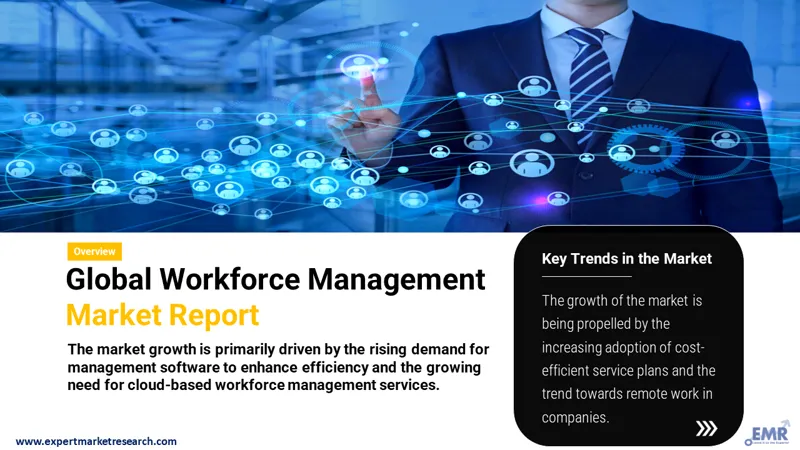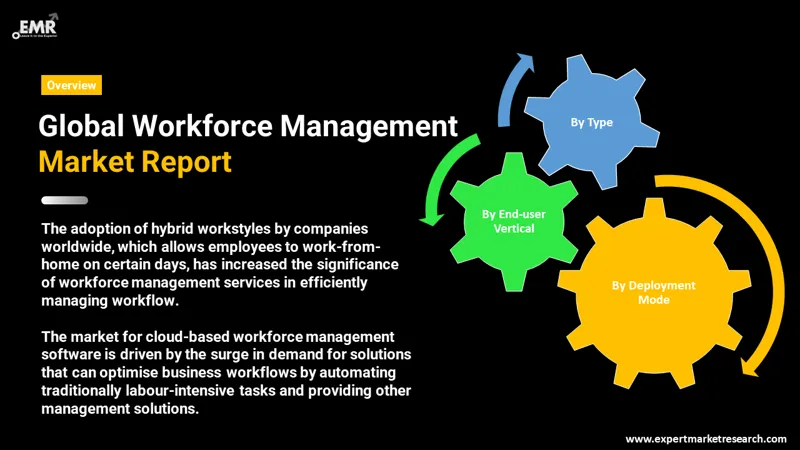
Consumer Insights
Uncover trends and behaviors shaping consumer choices today
Procurement Insights
Optimize your sourcing strategy with key market data
Industry Stats
Stay ahead with the latest trends and market analysis.
The global workforce management market size reached a value of more than USD 8.85 Billion in 2025. The global market is expected to grow at a CAGR of 9.20% in the forecast period of 2026-2035, likely to reach a value of USD 21.34 Billion by 2035.
Base Year
Historical Period
Forecast Period
Compound Annual Growth Rate
9.2%
Value in USD Billion
2026-2035
*this image is indicative*
Workforce management comprises of an integrated set of processes through which a company allocate resources, track attendance, and track goals for optimising productivity. WFM entails successfully estimating labour requirements and designing and controlling staff schedules to complete a certain activity on a daily and hourly basis.
Increasing Adoption of Work-From-Home Trend
Companies around the world are adopting hybrid workstyles by allowing employees to work-from-home on certain days and occasions. This has enhanced the importance of workforce management services for companies to efficiently manage their workflow.
Growing Demand for Cloud-based Workforce Management
The demand for cloud-based workforce management softwares has surged as they help business to optimise their workflow by enabling the company to automate tasks that are traditionally labour intensive, while also providing other management solutions.
Flexible Plans for Companies Based on their Needs
Software companies are curating cost-efficient management service plans based on company needs and size. This will allow smaller companies to adopt services and improve their work efficiency, which will further boost the market development.

Read more about this report - REQUEST FREE SAMPLE COPY IN PDF
The ongoing rapid industrialisation and commercial development in emerging regions has propelled the implementation of human resource management strategies to improve recruitment, attendance management, performance management, and documentation, among other processes. This can provide positive development opportunities to the market.
Small and medium sized companies are hesitant in adopting workforce management services due to the high initial cost for setup, management which requires skilled professionals, and infrastructure in case of on-premises management service. This can impede the market growth rate.

Read more about this report - REQUEST FREE SAMPLE COPY IN PDF
Global Workforce Management Market Report and Forecast 2026-2035 offers a detailed analysis of the market based on the following segments:
Market Breakup by Type
Market Breakup by Deployment Mode
Market Breakup by End-user Vertical
Market Breakup by Region
Based on deployment modes, the market bifurcations include on-premise and cloud. Technological developments and increasing demand for all-in-one solutions for workforce management and automation is driving the market growth. Thus, companies have been increasingly adopting cloud-based workforce management software helps business to optimise workflow and improve efficiency.
On-premise segment provides a premise installation option which provide full control on the upgrade and maintenance schedules, security configuration and patches, and access to the software. It is expected to experience steady growth in the market during the forecast period.
Based on end-user vertical, the market can be segmented into BFSI, consumer goods and retail, automotive, energy and utilities, healthcare, and manufacturing, among others. Among these segments, healthcare is expected to hold the largest share in the market owing to the increasing focus of healthcare organisations to reduce labour expenses and improve efficiency. Healthcare organisations are focusing on improving their communication methods, human resource staff, and talent acquisition.
The BFSI segment is also expected to hold a significant share of the market owing to theincreasing adoption of management softwares for automation of labour-intensive tasks.
The comprehensive EMR report provides an in-depth assessment of the market based on the Porter's five forces model along with giving a SWOT analysis. The report gives a detailed analysis of the following key players in the global market, covering their competitive landscape and latest developments like mergers, acquisitions, investments, and expansion plans.
ActiveOps PLC is a United Kingdom based software company that provide organisations with workforce automation services for various purposes to improve the workflow efficiency. The company was founded in 2005 and its headquarter is located in Reading, Berkshire.
NICE Ltd. is an Israel-based software company, which was founded in 1986. The company specialises in workforce engagement management, data security, surveillance, call centre software, and robotic process automation, among many other fields. They also offer one of the world’s largest cloud CX platform.
Oracle Corporation is one of the world’s largest computer technology companies which was founded in 1977. The company is headquartered in Texas, United States. The company is comprised of four main business sectors including cloud and license, hardware, and services. The company is known for its database management system, called Oracle database software.
*Please note that this is only a partial list; the complete list of key players is available in the full report. Additionally, the list of key players can be customized to better suit your needs.*
Other market players include Kronos Incorporated and Infor Group, among others.




*While we strive to always give you current and accurate information, the numbers depicted on the website are indicative and may differ from the actual numbers in the main report. At Expert Market Research, we aim to bring you the latest insights and trends in the market. Using our analyses and forecasts, stakeholders can understand the market dynamics, navigate challenges, and capitalize on opportunities to make data-driven strategic decisions.*
Get in touch with us for a customized solution tailored to your unique requirements and save upto 35%!
The market size reached a value of USD 8.85 Billion in 2025.
The market size is estimated to reach a value of USD 21.34 Billion in 2035.
The global market size is expected to grow at a CAGR of 9.20% during the period 2026-2035.
The market is driven by the increasing demand for management software to optimise efficiency and rapidly growing demand for cloud-based workforce management service.
The rising launch of cost-efficient service plans and adoption of work-from-home trend in companies is propelling the marker growth.
The regional markets for the global workforce management market include North America, Europe, the Asia Pacific, Latin America, the Middle East and Africa.
The different types of workforce management in the market include time and attendance management, workforce scheduling and workforce analytics, absence and leave management, performance and goal management, among others.
The deployment modes for workforce management include on-premise and cloud.
The end-user verticals for workforce management include BFSI, consumer goods and retail, automotive, energy and utilities, healthcare, and manufacturing, among others.
The key players in the market include ActiveOps PLC, NICE Ltd., Oracle Corporation, Kronos Incorporated, and Infor Group, among others.
Explore our key highlights of the report and gain a concise overview of key findings, trends, and actionable insights that will empower your strategic decisions.
| REPORT FEATURES | DETAILS |
| Base Year | 2025 |
| Historical Period | 2019-2025 |
| Forecast Period | 2026-2035 |
| Scope of the Report |
Historical and Forecast Trends, Industry Drivers and Constraints, Historical and Forecast Market Analysis by Segment:
|
| Breakup by Type |
|
| Breakup by Deployment Mode |
|
| Breakup by End-user Vertical |
|
| Breakup by Region |
|
| Market Dynamics |
|
| Competitive Landscape |
|
| Companies Covered |
|
Datasheet
One User
USD 2,499
USD 2,249
tax inclusive*
Single User License
One User
USD 3,999
USD 3,599
tax inclusive*
Five User License
Five User
USD 4,999
USD 4,249
tax inclusive*
Corporate License
Unlimited Users
USD 5,999
USD 5,099
tax inclusive*
*Please note that the prices mentioned below are starting prices for each bundle type. Kindly contact our team for further details.*
Flash Bundle
Small Business Bundle
Growth Bundle
Enterprise Bundle
*Please note that the prices mentioned below are starting prices for each bundle type. Kindly contact our team for further details.*
Flash Bundle
Number of Reports: 3
20%
tax inclusive*
Small Business Bundle
Number of Reports: 5
25%
tax inclusive*
Growth Bundle
Number of Reports: 8
30%
tax inclusive*
Enterprise Bundle
Number of Reports: 10
35%
tax inclusive*
How To Order

Select License Type
Choose the right license for your needs and access rights.

Click on ‘Buy Now’
Add the report to your cart with one click and proceed to register.

Select Mode of Payment
Choose a payment option for a secure checkout. You will be redirected accordingly.
Gain insights to stay ahead and seize opportunities.

Get insights & trends for a competitive edge.

Track prices with detailed trend reports.

Analyse trade data for supply chain insights.

Leverage cost reports for smart savings

Enhance supply chain with partnerships.

Connect For More Information
Our expert team of analysts will offer full support and resolve any queries regarding the report, before and after the purchase.
Our expert team of analysts will offer full support and resolve any queries regarding the report, before and after the purchase.
We employ meticulous research methods, blending advanced analytics and expert insights to deliver accurate, actionable industry intelligence, staying ahead of competitors.
Our skilled analysts offer unparalleled competitive advantage with detailed insights on current and emerging markets, ensuring your strategic edge.
We offer an in-depth yet simplified presentation of industry insights and analysis to meet your specific requirements effectively.
Share